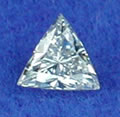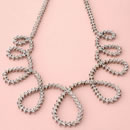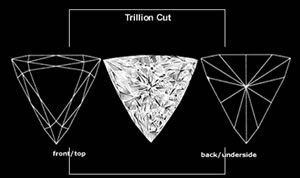Triangular Brilliant cut is often called a Trillion was first designed in Amsterdam by Leon Finker in 1978 and is cut into the shape of a wedge. The corners of this shape may be pointed or rounded and the body will vary depending on the stone’s characteristics and the cutter’s preference.
Triangular Brilliant and Triangular Modified Brilliant are generic terms referring to non-branded triangular brilliant cut diamonds. There are several other branded names for similar shapes including the following:
Trillian is an unregistered triangular cut.
Trilliant is another triangular cut, developed by H Meyer Diamond Co., whose patent has lapsed.
Trielle, or contemporary Trilliant, is a new name for Trilliant whose trademark has lapsed. The Trielle’s patent has expired by the name is still trademarked by Trillion Diamond Company
Trillion is yet another triangular cut and is one of the oldest terms.
Asscher’s Trilliant is a name used since the 1970’s by the Asscher Diamond Co of Amsterdam. They produced a triangular diamond with curved sides instead of straight ones and were an early version of what is now the Trielle.
Troidia is another unpatented triangular cut.
Trillium is a name for another unpatented triangular cut.

Tri-star is a newly patented cut and trademarked name for a triangular cut by Karp Impex
 With some exceptions, the finished diamond will generally contain 44 facets. Triangular Brilliants have straight sides while the Triangular Modified Brilliants have sides bowed outwards. An equilateral triangle (side millimeter measurements equal) is optimum; however, the non-branded Triangular Brilliant is more likely to display variation in measurement. At approximately 29 percent depth and less, the stone begins to lose brilliance.
With some exceptions, the finished diamond will generally contain 44 facets. Triangular Brilliants have straight sides while the Triangular Modified Brilliants have sides bowed outwards. An equilateral triangle (side millimeter measurements equal) is optimum; however, the non-branded Triangular Brilliant is more likely to display variation in measurement. At approximately 29 percent depth and less, the stone begins to lose brilliance.
 The Triangular Brilliant, whether branded or not, is most often sold as matched side stones for rings. Next in terms of volume are diamond stud earrings, followed by solitaire pendant necklaces and rings.
The Triangular Brilliant, whether branded or not, is most often sold as matched side stones for rings. Next in terms of volume are diamond stud earrings, followed by solitaire pendant necklaces and rings.
 In addition to traditional characteristics of good polish and symmetry, look for “windowing,” which are weak areas through the table where brilliancy is severely lacking. Avoid diamonds that display this brilliancy-defeating weakness.
In addition to traditional characteristics of good polish and symmetry, look for “windowing,” which are weak areas through the table where brilliancy is severely lacking. Avoid diamonds that display this brilliancy-defeating weakness.
 While fluorescence is not necessarily more common in triangles than in other makes, it becomes a more important issue when matching pairs are desired. If the diamonds should display fluorescence, look for matching degrees of fluorescence in pairs. If fluorescence levels are not evenly matched, even diamonds that are theoretically matched because their color grades are the same will appear as obvious mismatches for color. The degree of apparent mismatch will depend upon the light source and the level of fluorescence.
While fluorescence is not necessarily more common in triangles than in other makes, it becomes a more important issue when matching pairs are desired. If the diamonds should display fluorescence, look for matching degrees of fluorescence in pairs. If fluorescence levels are not evenly matched, even diamonds that are theoretically matched because their color grades are the same will appear as obvious mismatches for color. The degree of apparent mismatch will depend upon the light source and the level of fluorescence.
Measurements provided on certifications are for the length, width and depth of the triangular brilliant, not the tip to tip measurements. In order to have an equilateral triangle, the length to width ratio needs to be about 1.12. The length measurement is the longest side and the width is the height of the diamond (distance from the length side to the opposite point).

